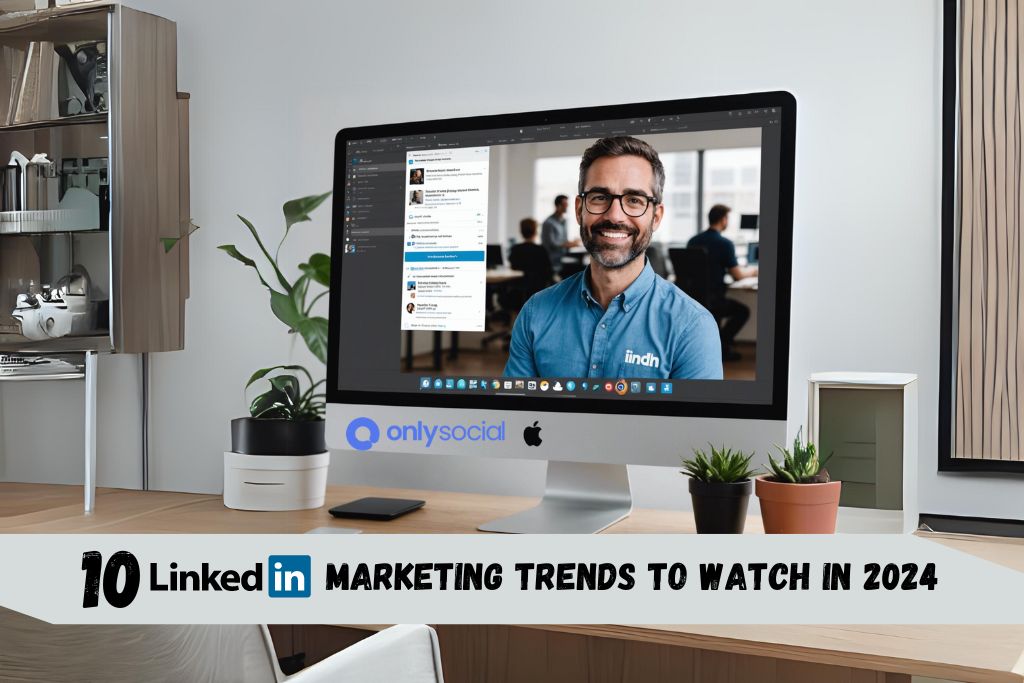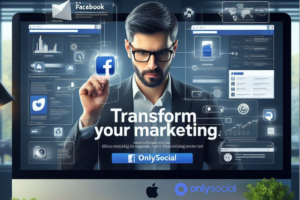As we step into 2024, the landscape of digital marketing continues to evolve, with LinkedIn emerging as a powerhouse for professionals and businesses alike. In this dynamic environment, understanding and leveraging the latest trends is not just beneficial—it’s essential for staying competitive and relevant. This year, “10 LinkedIn Marketing Trends” have come to the forefront, each offering unique opportunities and challenges for marketers aiming to maximize their presence on the platform. From the integration of advanced AI technologies to the growing importance of video content and personal branding, these trends are shaping the way businesses connect, engage, and succeed on LinkedIn.
As we delve into each trend, marketers must grasp their implications, adapt their strategies accordingly, and explore innovative ways to engage their target audience. By staying informed and agile, marketers can not only keep pace with the changing digital landscape but also future-proof their LinkedIn marketing strategies, ensuring sustained growth and success in the digital age.
Table of Contents
- 1 Rise of AI and Automation Tools in LinkedIn Marketing
- 2 Video Content Dominance
- 3 Enhanced LinkedIn Analytics and Metrics
- 4 Personal Branding and Thought Leadership
- 5 LinkedIn for B2B Marketing
- 5.0.1 Understanding the Power of LinkedIn in B2B Marketing
- 5.0.2 Aligning with the 10 LinkedIn Marketing Trends for Enhanced B2B Strategy
- 5.0.3 Lead Generation Tactics on LinkedIn
- 5.0.4 Building Meaningful Professional Relationships
- 5.0.5 Leveraging LinkedIn Analytics for B2B Success
- 5.0.6 Case Studies: Successful B2B Marketing Campaigns on LinkedIn
- 5.0.7 Future-Proofing Your LinkedIn B2B Marketing Strategy
- 6 Increased Focus on Employee Advocacy
- 7 Content Personalization and Targeting
- 8 Growth of LinkedIn Groups and Communities
- 9 Sustainability and Corporate Responsibility
- 10 Evolving LinkedIn SEO Practices
- 11 BONUS
- 12 Frequently Asked Questions
Rise of AI and Automation Tools in LinkedIn Marketing
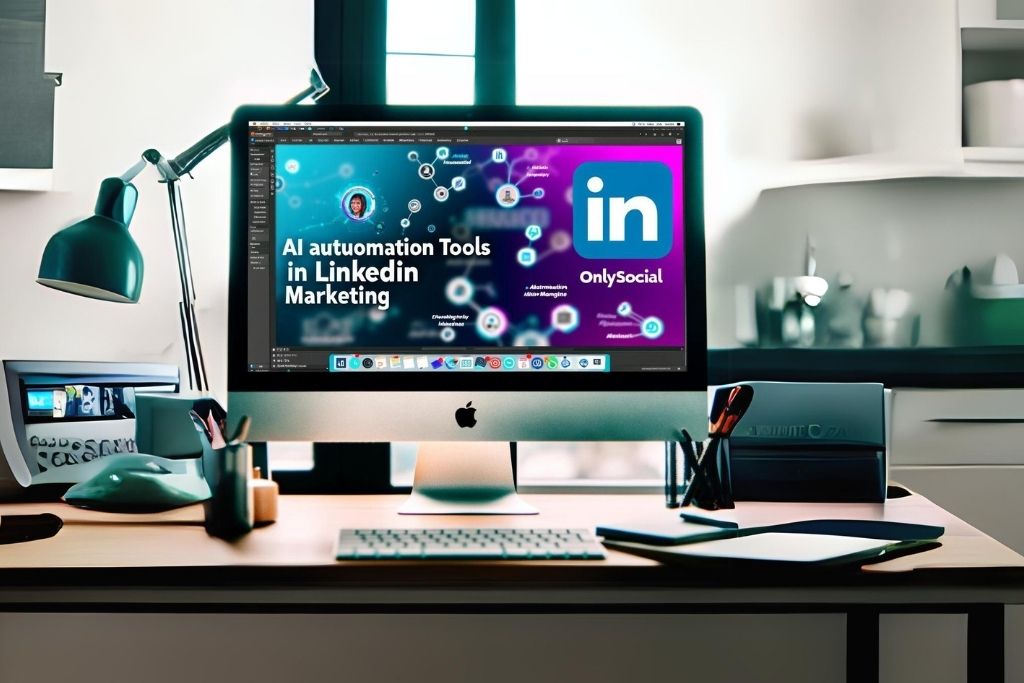
The integration of Artificial Intelligence (AI) and automation tools into LinkedIn marketing strategies is a game-changer, positioning itself as one of the top 10 LinkedIn Marketing Trends to watch in 2024. These technologies are revolutionizing the way businesses interact with their audience, manage content, and analyze data on LinkedIn, offering unprecedented levels of efficiency and personalization.
Understanding AI and Automation in LinkedIn Marketing
AI and automation technologies encompass a broad range of applications, from content creation and recommendation algorithms to chatbots and sophisticated analytics platforms. These tools can automate repetitive tasks, such as posting schedules and responding to routine inquiries, freeing up marketers to focus on strategy and creative content creation.
Tools for Enhanced Efficiency and Engagement
Several AI-powered tools are now available that can help with various aspects of LinkedIn marketing. For instance, AI-driven content creation tools can generate engaging posts tailored to your target audience, while automation platforms can schedule these posts for optimal engagement times. Furthermore, chatbots can provide immediate responses to queries on LinkedIn, improving customer service and engagement.
Personalization at Scale
One of the most significant advantages of AI and automation is the ability to personalize content at scale. By analyzing user data and behaviour, AI can help tailor messages and content to individual preferences and interests, significantly increasing engagement rates. This level of personalization was once only achievable with extensive resources but is now accessible to businesses of all sizes thanks to AI.
The Future of AI in LinkedIn Marketing
As LinkedIn continues to evolve, the role of AI and automation in marketing strategies is expected to grow. Future trends may include more advanced predictive analytics, deeper integration of AI in LinkedIn’s algorithm for content visibility, and more intuitive automation tools that further simplify marketing tasks.
Leveraging AI and Automation for Competitive Advantage
To stay ahead in the competitive landscape of LinkedIn marketing, businesses should explore and adopt AI and automation tools. Whether it’s through personalized content creation, efficient management of campaigns, or leveraging advanced analytics for strategic insights, these technologies offer a pathway to not just keep pace with trends but to lead in the LinkedIn marketing space.
Incorporating AI and automation into your LinkedIn marketing strategy not only aligns with the current trends but also future-proofs your efforts, ensuring that your brand remains relevant and competitive in the dynamic digital marketing environment of 2024.
Video Content Dominance
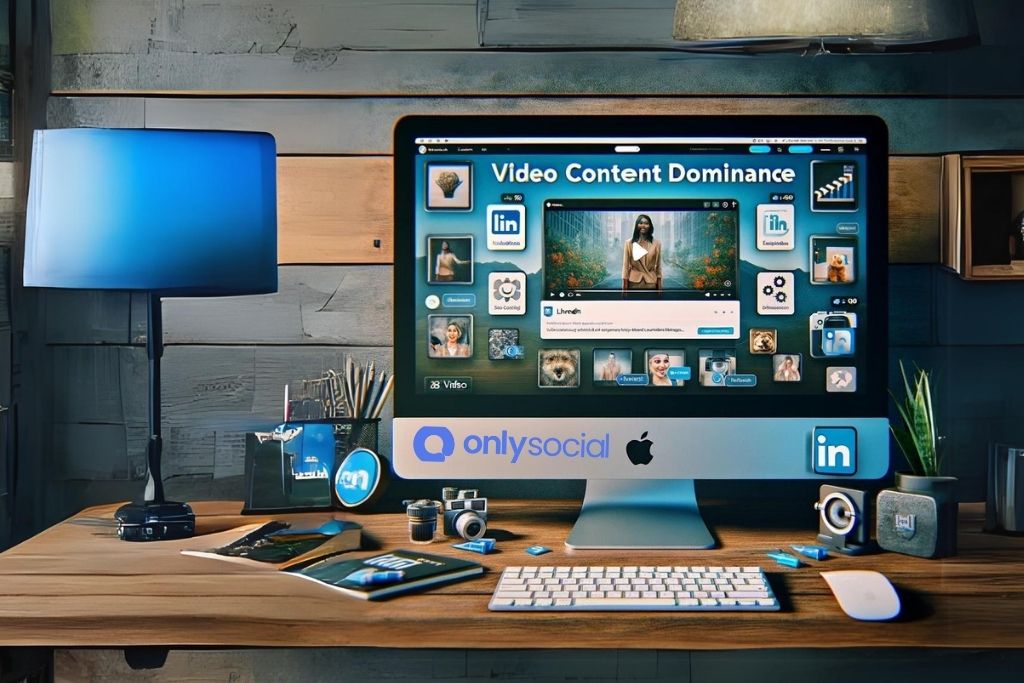
As one of the 10 LinkedIn marketing trends to watch in 2024, video content continues to assert its dominance on the platform, reflecting broader digital marketing shifts. LinkedIn, traditionally a hub for professional networking and content sharing, has seen a significant uptick in video engagement, with users not only consuming more video content but also preferring it over text-based posts. This trend underscores the evolving nature of LinkedIn as a dynamic marketing tool, necessitating a strategic approach to video content creation and distribution.
Understanding the Impact of Video on Engagement
Video content on LinkedIn enjoys higher engagement rates compared to other content types. This section will delve into the statistics that highlight the growing preference for video among LinkedIn users, including views, shares, and the overall impact on audience engagement. We’ll explore why video content resonates so strongly with the professional audience on LinkedIn and how it can lead to increased visibility and interaction for brands.
Tips for Creating Compelling LinkedIn Video Content
Crafting video content that captivates and engages a professional audience requires a nuanced approach. This segment will provide actionable tips for creating videos that stand out on LinkedIn. From understanding the ideal length and format for LinkedIn videos to the importance of high-quality visuals and sound, we’ll cover the essential elements that contribute to successful video content on the platform. Additionally, we’ll discuss how to convey your brand’s message effectively within the professional context of LinkedIn.
Leveraging LinkedIn Live for Real-Time Engagement
LinkedIn Live represents a significant opportunity for real-time engagement with your audience. This section will outline the benefits of using LinkedIn Live as part of your video marketing strategy. We’ll provide guidance on how to plan and execute a successful live broadcast, including best practices for promoting your live session, engaging with viewers during the broadcast, and repurposing your live content for ongoing value.
Maximizing Reach with Video Ads
Video ads on LinkedIn offer a powerful way to expand your reach and target specific audiences. This part of the article will explore the different types of video ads available on LinkedIn, including sponsored content, messaging ads, and dynamic ads. We’ll delve into strategies for creating effective video ad campaigns, from targeting and customization to measuring and optimizing performance. By leveraging video ads, marketers can significantly enhance their visibility and impact on LinkedIn.
Staying Ahead of the Curve
As video content continues to dominate LinkedIn, staying informed about the latest trends and features is crucial for marketers looking to make an impact. This section will touch on emerging video formats and technologies, such as augmented reality (AR) and virtual reality (VR), and their potential applications within LinkedIn marketing strategies. By embracing innovative video content approaches, brands can differentiate themselves and engage their LinkedIn audience in new and exciting ways.
Incorporating video content into your LinkedIn marketing strategy is not just a trend—it’s an essential component of engaging and connecting with your professional audience in 2024. By understanding the importance of video content, creating compelling and relevant videos, leveraging live broadcasts, and utilizing video ads effectively, marketers can ensure their brands stand out on LinkedIn and capitalize on the platform’s growing preference for video.
Enhanced LinkedIn Analytics and Metrics
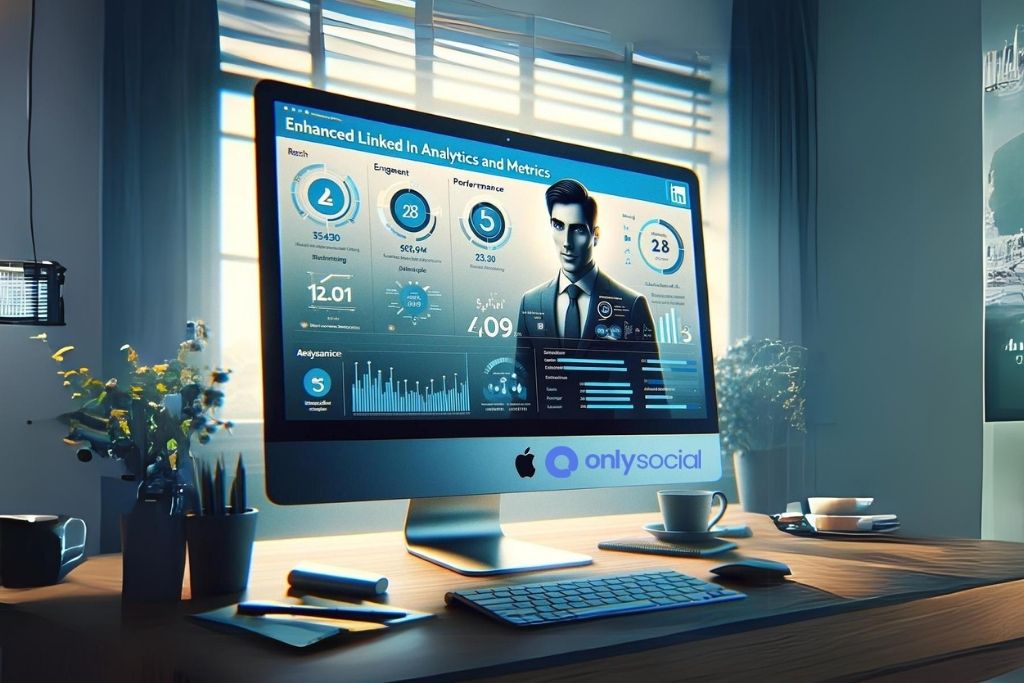
The continuous evolution of LinkedIn into a premier platform for professional networking and marketing has made understanding and leveraging its analytics and metrics more crucial than ever. As one of the top 10 LinkedIn marketing trends to watch in 2024, enhanced analytics and metrics offer unprecedented insights into campaign performance, audience behaviour, and content engagement. This trend underscores the platform’s commitment to providing marketers with the tools they need to refine their strategies and achieve better outcomes.
Understanding LinkedIn’s New Analytics Features
LinkedIn has introduced a range of new analytics features designed to give marketers a deeper understanding of their audience and the performance of their content. These enhancements include more detailed demographic information, improved tracking of engagement metrics, and the ability to measure the impact of specific posts and campaigns more accurately. Marketers can now segment their audience based on job function, seniority, industry, and more, enabling more targeted content strategies.
Leveraging Analytics to Improve Marketing Strategies
The key to leveraging LinkedIn’s enhanced analytics lies in understanding what the data tells you about your audience and their preferences. By analyzing engagement trends, click-through rates, and conversion metrics, marketers can identify what types of content resonate most with their target audience. This insight allows for the optimization of content calendars, the refinement of messaging, and the adjustment of posting schedules to maximize reach and engagement.
Practical Tips for Using LinkedIn Analytics
- Regularly Monitor Performance Metrics: Keep a close eye on key performance indicators (KPIs) such as engagement rate, impressions, and conversion rates to understand what works and what doesn’t.
- Experiment with Content Types: Use analytics to test the effectiveness of different content formats, including articles, videos, and infographics, to see what drives the most engagement and conversions.
- Optimize for Peak Engagement Times: Analyze when your audience is most active on LinkedIn and schedule your posts accordingly to increase visibility.
- Track Competitor Performance: Utilize LinkedIn analytics to benchmark your performance against competitors and identify areas for improvement.
Case Studies on Successful Data-Driven LinkedIn Campaigns
Examining successful LinkedIn campaigns that were driven by data insights can provide valuable lessons for marketers. Case studies often reveal how businesses of all sizes have used analytics to tailor their content, target their advertising more effectively, and significantly improve their return on investment (ROI). These real-world examples can serve as a blueprint for leveraging enhanced LinkedIn analytics and metrics to drive marketing success.
Incorporating the sophisticated use of LinkedIn’s enhanced analytics and metrics into your marketing strategy is not just about keeping up with the trends; it’s about staying ahead of the curve. As we move through 2024, the ability to harness these insights will become a pivotal factor in the success of LinkedIn marketing efforts.
Personal Branding and Thought Leadership
As one of the essential 10 LinkedIn Marketing Trends to watch in 2024, personal branding and thought leadership stand out as critical components for professionals aiming to distinguish themselves in a crowded marketplace. This trend underscores the shift towards recognizing the power of individual voices within the corporate sphere, emphasizing the value of building a personal brand alongside corporate branding efforts.
Understanding the Impact
- Definition and Importance: Clarify what personal branding and thought leadership entail and why they are increasingly vital on platforms like LinkedIn.
- Impact on Career and Business Growth: Discuss how a strong personal brand and thought leadership position can open new opportunities, attract clients, and enhance career prospects.
Strategies for Establishing Thought Leadership
- Content Creation: Detail the types of content that can establish a professional as a thought leader, including articles, posts, and videos that address industry trends, insights, and forward-thinking ideas.
- Engagement and Consistency: Emphasize the importance of regular engagement with your network and the LinkedIn community through comments, posts, and shares to build visibility and credibility.
- Utilizing LinkedIn Features: Explore how features like LinkedIn Articles, LinkedIn Live, and LinkedIn Learning can be leveraged to showcase expertise and share knowledge.
Building Your Personal Brand on LinkedIn
- Profile Optimization: Offer tips for optimizing LinkedIn profiles to reflect personal branding, including professional headshots, compelling bios, and showcasing achievements and endorsements.
- Networking Strategies: Advise on building and nurturing a network that supports and amplifies your personal brand, focusing on quality connections over quantity.
- Personal vs. Professional Content: Guide on balancing personal insights and professional achievements to create a relatable yet authoritative personal brand.
Challenges and Opportunities
- Standing Out in a Saturated Market: Discuss strategies for differentiating oneself in a competitive field, focusing on unique value propositions and authentic storytelling.
- Adapting to Industry Changes: Highlight the importance of staying informed about industry trends and how to position oneself as a leader in adapting to and commenting on these changes.
Leveraging Trends for Thought Leadership
- Integration with Other LinkedIn Marketing Trends: Explain how personal branding and thought leadership intersect with other trends, such as video content and AI-driven personalization, to maximize impact on LinkedIn.
By embracing the trend of personal branding and thought leadership, professionals can effectively utilize LinkedIn to not only enhance their visibility and influence but also to contribute significantly to the evolving landscape of their industries. This strategic approach enables individuals to not only keep pace with but excel within the dynamic realm of LinkedIn marketing in 2024.
LinkedIn for B2B Marketing
Understanding the Power of LinkedIn in B2B Marketing
- Introduction to LinkedIn’s role in B2B marketing
- The unique advantages LinkedIn offers for connecting with professionals and decision-makers
Aligning with the 10 LinkedIn Marketing Trends for Enhanced B2B Strategy
- How the latest trends can shape your B2B marketing efforts on LinkedIn
- Incorporating AI, video content, and personal branding into your B2B strategy
Lead Generation Tactics on LinkedIn
- Tips for using LinkedIn features to generate leads, including InMail campaigns, Sponsored Content, and Lead Gen Forms
- Best practices for creating compelling, targeted content that resonates with B2B audiences
Building Meaningful Professional Relationships
- Strategies for engaging with industry leaders and potential clients through thoughtful content and participation in relevant groups
- The importance of employee advocacy in expanding your reach and credibility
Leveraging LinkedIn Analytics for B2B Success
- Utilizing LinkedIn’s analytics tools to track the performance of your marketing efforts and adjust strategies accordingly
- Identifying key metrics that matter for B2B marketing, such as lead conversion rates and engagement levels
Case Studies: Successful B2B Marketing Campaigns on LinkedIn
- Real-world examples of companies that have effectively used LinkedIn for B2B marketing
- Lessons learned and insights from these success stories
Future-Proofing Your LinkedIn B2B Marketing Strategy
- Staying ahead of the curve by adapting to emerging trends in the LinkedIn landscape
- Continuous learning and experimentation with new features and strategies to maintain a competitive edge in B2B marketing
Increased Focus on Employee Advocacy
As one of the 10 LinkedIn Marketing Trends to watch in 2024, the focus on employee advocacy is reshaping how companies approach their LinkedIn marketing strategies. This trend underscores the power of leveraging employees’ networks and voices to amplify brand messages, foster organic engagement, and enhance brand reputation on LinkedIn.
Understanding Employee Advocacy
Employee advocacy refers to the promotion of an organization by its staff members. On LinkedIn, this can take various forms, including sharing company updates, participating in industry-related discussions, and publishing content that reflects their professional experiences and insights. This strategy taps into the authentic voices of employees, which often carry more weight and trustworthiness than corporate messaging alone.
Benefits of Employee Advocacy on LinkedIn
- Extended Reach and Visibility: Employees collectively have a network far larger than the company’s LinkedIn page. By encouraging advocacy, companies can significantly expand their content’s reach.
- Increased Engagement: Content shared by employees receives higher engagement rates than content shared through corporate channels. Personal connections are more likely to interact with content shared by someone they know.
- Authenticity and Trust: Messages shared by employees are perceived as more authentic and credible, enhancing the company’s brand image and trust among its audience.
- Talent Attraction and Retention: Showcasing company culture and employee experiences can attract prospective talent and improve current employee satisfaction and loyalty.
Implementing an Effective Employee Advocacy Program
- Provide Clear Guidelines: Establish clear guidelines on what employees can and should share to ensure consistency with the brand voice and compliance with regulatory requirements.
- Offer Content That’s Easy to Share: Create shareable content that employees can easily post on their profiles, including news, insights, and achievements related to your company or industry.
- Encourage Participation: Motivate employees by recognizing their contributions to the program and providing incentives or rewards for active participation.
- Measure and Optimize: Track the performance of your employee advocacy program using LinkedIn’s analytics tools to understand its impact on your marketing goals and make necessary adjustments.
Challenges and Considerations
While employee advocacy offers numerous benefits, it also presents challenges such as maintaining a balance between professional and personal content on employees’ profiles and ensuring voluntary participation. Companies must foster a culture that encourages sharing and provides the necessary support and training for employees to become effective advocates.
By integrating employee advocacy into their LinkedIn marketing strategy, organizations can leverage one of the key trends of 2024 to enhance their online presence, build stronger relationships with their audience, and drive business outcomes through the power of their employees’ networks.
Content Personalization and Targeting
As one of the pivotal 10 LinkedIn Marketing Trends to watch in 2024, content personalization and targeting stand out for their capacity to significantly enhance user engagement and conversion rates on the platform. LinkedIn’s sophisticated algorithms and data analytics tools have made it easier for marketers to deliver highly relevant content to their target audience, ensuring that the messaging resonates on a more personal level.
Understanding LinkedIn’s Content Personalization Capabilities
- Dynamic Content Creation: How marketers can use LinkedIn features to customize content based on user profiles, interests, and behaviors.
- Segmentation Tools: An overview of LinkedIn’s segmentation capabilities, allowing for targeted content strategies that cater to specific industry, job functions, or seniority levels.
Strategies for Effective Targeting on LinkedIn
- Audience Insights: Leveraging LinkedIn’s analytics to gain deep insights into your audience’s preferences and behaviors.
- Personalized Messaging: Tips for crafting personalized messages that speak directly to the needs and interests of your target segments.
- A/B Testing: Utilizing A/B testing to refine your targeting strategy and improve content performance.
Leveraging LinkedIn for Tailored Content Delivery
- Sponsored Content: Best practices for using LinkedIn Sponsored Content to reach a wider yet targeted audience.
- InMail Campaigns: How personalized InMail messages can drive higher engagement compared to standard email marketing campaigns.
- Content Series: Creating a series of posts tailored to different audience segments to maintain interest and engagement over time.
Advanced Targeting Techniques
- Retargeting Campaigns: Strategies for implementing retargeting on LinkedIn to re-engage visitors who showed interest in your content or services.
- Lookalike Audiences: Expanding your reach by targeting new users who share characteristics with your best-performing audience segments.
Future Trends in Personalization and Targeting
- Predictive Analytics: The role of predictive analytics in enhancing content personalization and targeting strategies on LinkedIn.
- AI-Driven Content Recommendations: How AI is expected to revolutionize the way content is personalized and delivered to users, making it more relevant and engaging than ever.
By embracing content personalization and targeting, marketers can ensure their strategies align with the evolving landscape of LinkedIn marketing in 2024. This approach not only improves the user experience by providing value through tailored content but also drives better marketing outcomes by reaching the most relevant audiences with precision.
Growth of LinkedIn Groups and Communities
As we explore the 10 LinkedIn Marketing Trends to watch in 2024, a significant highlight is the growth of LinkedIn Groups and Communities. This trend underscores the platform’s evolving nature as a hub not just for professional networking but for fostering deeper, interest-based connections and discussions. Here’s a detailed look into why LinkedIn Groups and Communities are gaining momentum and how marketers can leverage them.
The Revival of LinkedIn Groups
- Introduction to LinkedIn Groups: An overview of what LinkedIn Groups are and their purpose.
- Historical Context: Brief history on the fluctuating popularity of LinkedIn Groups and the platform’s efforts to rejuvenate them.
- 2024 Trends: Insights into how LinkedIn has made Groups more accessible and valuable, contributing to their resurgence.
The Importance of Communities in Professional Networking
- Building Professional Communities: Discussion on the role of communities in building professional networks and sharing industry-specific knowledge.
- Engagement Over Broadcast: Shift from one-way communication to fostering genuine discussions and engagement within groups.
Strategies for Leveraging LinkedIn Groups for Marketing
- Identifying Relevant Groups: Tips on finding and joining groups that align with your business interests and marketing goals.
- Creating Your Own LinkedIn Group: Step-by-step guide on starting a successful LinkedIn Group, including setting the purpose, rules, and engagement strategies.
- Content Strategy for Groups: Best practices for content creation within groups, focusing on value-driven discussions rather than direct promotion.
Engaging with Communities for Brand Building
- Thought Leadership: How to establish yourself or your company’s executives as thought leaders within LinkedIn communities.
- User-Generated Content: Encouraging group members to share their content, experiences, and questions, enhancing the group’s value and engagement.
Challenges and Solutions
- Moderation and Management: Addressing the challenges of moderating LinkedIn Groups to maintain a professional and respectful environment.
- Measuring Success: Tools and metrics to assess the effectiveness of your engagement in LinkedIn Groups and its impact on your overall LinkedIn marketing strategy.
Future Prospects
- Predictions for LinkedIn Groups: How LinkedIn might further enhance Groups and Communities features to support professional networking and marketing.
- Integrating Groups into Broader Marketing Strategies: Discuss the potential for LinkedIn Groups to integrate with other marketing channels and strategies, enhancing overall campaign cohesion and impact.
As part of the 10 LinkedIn Marketing Trends for 2024, the growth of LinkedIn Groups and Communities is not just a resurgence of a feature but a paradigm shift in how professionals connect, share, and learn on the platform. For marketers, this trend presents new avenues to engage with targeted audiences, foster brand loyalty, and build authority in their industry.
Sustainability and Corporate Responsibility
As we delve into the 10 LinkedIn Marketing Trends for 2024, a significant shift towards sustainability and corporate responsibility emerges as a pivotal movement. This trend underscores the growing importance for businesses to communicate their commitments to environmental stewardship, ethical practices, and community involvement directly on their LinkedIn profiles and through their content strategies. Here’s how companies can effectively leverage this trend:
Understanding the Impact
- Start with a discussion on why sustainability and corporate responsibility are becoming crucial in consumer and partner decisions. Highlight the increasing demand from stakeholders for transparency and accountability in business operations.
Integrating Sustainability into Your LinkedIn Strategy
- Offer guidance on how businesses can showcase their sustainable practices and CSR initiatives on LinkedIn. This includes updating company pages with information on sustainability goals, achievements, and ongoing projects.
- Emphasize the role of storytelling in making these efforts relatable and engaging to the LinkedIn audience. Use real-world examples of posts, articles, and videos that have successfully highlighted CSR efforts.
Employee Advocacy for Amplified Impact
- Discuss how employees can serve as powerful ambassadors for a company’s sustainability efforts on LinkedIn. Encourage the promotion of volunteer activities, participation in green initiatives, and sharing of the company’s CSR milestones by employees through their personal LinkedIn profiles.
- Provide tips on creating a structured program to facilitate and motivate employee advocacy on sustainability matters.
Leveraging LinkedIn Features for CSR Engagement
- Dive into specific LinkedIn features that can help in promoting sustainability and corporate responsibility, such as LinkedIn Articles for in-depth stories, LinkedIn Groups for community engagement, and LinkedIn Live for hosting discussions or panels on relevant topics.
- Explain how to use hashtags effectively to increase the visibility of CSR-related content and join broader conversations on sustainability within the LinkedIn ecosystem.
Collaborating with Like-Minded Organizations
- Highlight the importance of partnering with other organizations, NGOs, and industry groups on LinkedIn to co-host events, share content, and collaborate on sustainability projects. Show how these partnerships can extend the reach of CSR efforts and foster a sense of community and shared purpose.
Measuring the Impact of CSR on LinkedIn
- Conclude with advice on tracking and measuring the impact of sustainability and corporate responsibility content on LinkedIn. Discuss the use of LinkedIn analytics to understand engagement levels, audience growth, and the overall influence of CSR communications on brand perception.
By integrating sustainability and corporate responsibility into their LinkedIn marketing strategies, businesses not only contribute positively to their communities and the planet but also align with the evolving expectations of their audiences. This alignment, part of the broader 10 LinkedIn Marketing Trends, showcases a company’s commitment to making a difference, thereby strengthening its brand and fostering deeper connections with its audience.
Evolving LinkedIn SEO Practices
As we explore the forefront of “10 LinkedIn Marketing Trends” for 2024, an essential element not to overlook is the evolving landscape of LinkedIn SEO practices. With LinkedIn not just being a networking site but also a powerful content platform, understanding and leveraging SEO within LinkedIn can significantly enhance your visibility and engagement. Here’s how to adapt to these changes and ensure your LinkedIn content reaches its intended audience effectively.
Understanding LinkedIn’s Search Algorithm
- Explanation of how LinkedIn’s search algorithm works and its importance for marketing.
- The role of keywords, profile completeness, and engagement metrics in improving your visibility.
- Tips for staying updated with LinkedIn’s algorithm changes to maintain a high SEO ranking.
Optimizing Your LinkedIn Profile for Search
- Strategies for incorporating keywords into your LinkedIn profile, including headline, summary, and experience sections.
- Importance of customizing your LinkedIn URL and how it impacts your SEO.
- Recommendations for profile elements that are crucial for SEO, such as skills, endorsements, and recommendations.
Content Optimization Strategies
- Best practices for keyword optimization in your LinkedIn articles, posts, and even comments.
- How to use hashtags effectively to increase the reach of your content.
- The significance of posting frequency and timing for enhancing content visibility and engagement.
Leveraging LinkedIn Articles for SEO
- The benefits of publishing articles on LinkedIn for SEO and thought leadership.
- Techniques for optimizing your articles with keywords, images, and links to increase discoverability.
- Analyzing the impact of article engagement (likes, comments, shares) on your content’s SEO performance.
Building Quality Connections and Engagements
- The impact of your network size and engagement levels on your content’s visibility.
- Strategies for increasing meaningful interactions on your posts to boost your SEO ranking.
- The importance of engaging with other users’ content and how it contributes to your overall LinkedIn SEO strategy.
Monitoring and Adapting to SEO Trends
- Tools and methods for tracking your LinkedIn content’s performance and SEO effectiveness.
- Keeping an eye on emerging LinkedIn features and trends that could affect SEO strategies.
- Continuous learning and adaptation as key to staying ahead in the dynamic environment of LinkedIn SEO.
By integrating these evolving LinkedIn SEO practices into your overall marketing strategy, you’re not just keeping up with the “10 LinkedIn Marketing Trends” for 2024; you’re setting a foundation for sustained visibility and success on the platform. Whether you’re looking to boost your personal brand or enhance your company’s online presence, understanding and applying these SEO techniques will be instrumental in achieving your LinkedIn marketing goals.
BONUS
Embrace 2024’s LinkedIn marketing trends with AI-driven content, employee advocacy, and video engagement. Authenticity, real-time interaction, and a blend of organic and paid strategies are key. OnlySocial’s Post Planning and Scheduling tool is essential for leveraging these trends, offering unlimited posting across all social networks. Streamline your strategy, ensure consistent audience engagement, and elevate your LinkedIn presence. Start with a commitment-free 7-day trial today.
Frequently Asked Questions
What are the key components of a successful LinkedIn marketing strategy in 2024? A successful LinkedIn marketing strategy in 2024 should focus on leveraging AI and automation for efficiency, creating engaging video content, utilizing advanced analytics for data-driven decisions, building personal and company brand through thought leadership, and maximizing B2B marketing opportunities. It should also include strategies for employee advocacy, personalized content, active participation in groups and communities, showcasing sustainability efforts, and optimizing for LinkedIn SEO.
How can I use video content effectively on LinkedIn? To use video content effectively on LinkedIn, focus on creating short, engaging videos that provide value to your audience. Use storytelling to make your message relatable, include captions for accessibility, and incorporate a clear call to action. Experiment with LinkedIn Live to connect with your audience in real-time, offering insights, Q&As, or behind-the-scenes looks at your business.
Can small businesses benefit from LinkedIn marketing? Absolutely. Small businesses can benefit significantly from LinkedIn marketing by building a strong company page, sharing valuable content, leveraging LinkedIn ads for targeted campaigns, and networking in industry-specific groups. LinkedIn provides a platform for small businesses to establish thought leadership, generate leads, and build professional networks.
What are the most effective LinkedIn SEO practices? Effective LinkedIn SEO practices include optimizing your profile with relevant keywords, publishing SEO-friendly articles and posts, using hashtags wisely, and engaging with others to increase your content’s reach. Regularly update your profile, stay active with meaningful content, and monitor your analytics to understand what works best for your audience.
How do I measure the ROI of my LinkedIn marketing efforts? Measuring the ROI of LinkedIn marketing involves tracking key performance indicators (KPIs) such as engagement rates, lead generation metrics, website traffic from LinkedIn, and conversion rates. Utilize LinkedIn’s analytics tools to monitor these metrics and assess how well your marketing efforts are contributing to your business objectives.
What’s the best posting frequency on LinkedIn to maximize engagement? The optimal posting frequency on LinkedIn varies depending on your audience and content type. However, a general recommendation is to post 2-5 times per week to maintain visibility without overwhelming your followers. Quality over quantity is crucial; focus on delivering valuable content that resonates with your audience.
Is LinkedIn marketing effective for B2C companies? While LinkedIn is primarily seen as a B2B platform, B2C companies can still find value in using it for brand awareness, employer branding, and thought leadership. B2C companies can share stories about their culture, highlight CSR initiatives, and engage with consumers on a more personal and professional level.

